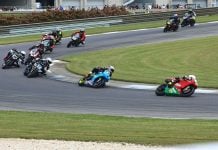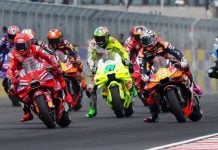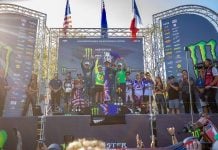FIRST PERSON/OPINION: A Look At Current AMA Officiating
Cutting The Course: What’s the Price?
By Michael Gougis
Team Roadracingworld.com’s Chris Ulrich got into a corner too hot and ran off the course during the AMA Superstock race at California Speedway earlier this season. Ulrich lost two positions and two seconds. With most sanctioning bodies, that would have been penalty enough.
But with the AMA supplemental regulations in place for that race, more penalties awaited Ulrich. AMA officials say he did not follow the precise additional rules formulated for re-entering the track specifically at California Speedway Ulrich, they say, went through one set of cones positioned in a haybale chicane, but failed to negotiate a second set of cones leading riders back onto the track. He got the meatball flag and was hauled into the pits for a penalty during the race, dropping him from eighth position and gaining on a fight for sixth to 12th, where he finished.
“I did exactly what the AMA’s Morgan Broadhead told me to do in the riders’ meeting. He said, ‘You get off the track over there, you have to go through the cones pointing in,'” Ulrich said in a news release.
“I did exactly that, following the printed bulletin the AMA had given to the riders. I lost two positions and countless seconds, yet still I was penalized. That was a potential sixth place, a very good finish. And now it’s 12th place and (I) probably lost another position or two in points. I’m extremely disappointed in how it turned out. I do not think the ruling was fair or correct.”
“I must start by saying that I was surprised that Chris received a drive-thru penalty at Cal Speedway,” fellow racer Jason Curtis said in an e-mail to Roadracing World. “Chris did in fact take the detour the AMA laid out to slow riders down to keep from gaining an advantage blowing that corner. I was far enough back that as he pulled back on the track, Chris did not gain any advantage on me…yet I did on him. Chris slowed down, followed the rules and kept racing. What did he do wrong?”
“When I witnessed Chris run off on lap three he did follow the correct path thru the haybales,” racer Scott Jensen said in another e-mail. “He went from in front of me to behind me, I did see him in my peripheral vision go thru the proper route. I must say it did take a pretty extreme effort on his part to get way back over to the haybale chicane.”
AMA officials concede that Ulrich wasn’t penalized for endangering another rider or gaining positions or time. They insist that in issuing the penalty, they followed the special rules that were in place for that race at California Speedway, a “roval” (combination road course/oval) that hosts an AMA round mostly because of its proximity to the large motorcycling community of Southern California and the corporate presence of the major Japanese manufacturers.
And by the time the green flags flew at Fontana, those “special rules” had gotten very, very complex. By the time the racing started, riders had to know the main AMA rulebook, the rules in the supplemental regulations for Fontana, and an addendum to the supplemental regulations handed out to mechanics at tech inspection.
If you blew Turn One, one set of procedures had to be followed. If you blew Turns Two and Eight, another set of procedures. And if you missed Turn 12 at the end of the back straight, yet another set of procedures. Get any of them wrong and you got a meatball flag.
Yipes.
California Speedway’s facility and its amenities are nice, but the course, with its temporary curbing and chicanes, is not in the league of the classic tracks like Road America, Laguna Seca, et. al. Hosting a race at a facility like this leads to certain challenges and policing course cuts is one of the big ones. And while Broadhead, AMA Pro Racing Road Race Manager, said the association followed its rules when penalizing Ulrich, he also conceded that the organizers could have made the supplemental rules clearer and would continue to make improvements.
“I actually set up the chicane with Cory West, the rider’s representative, and he also felt it was clear and understandable,” Broadhead said. “Of the 40-plus riders who left the course at that point during the weekend, more than 30 of them re-entered correctly.
“But I can certainly see where someone could think they were doing it correctly and, in good faith, get it wrong. Could we have set this up in a way that makes it more foolproof? Absolutely. California Speedway’s layout offers unique challenges. Every time we go there, we learn something. And we’ll try to make it better next year.”
This year’s event had far fewer course cuts than in prior years. But it also showed up shortcomings in the AMA’s plan for reducing course cuts and the way that plan was communicated to the racers.
Like almost every other sanctioning body’s rulebook, the AMA’s main road racing rulebook states: “A rider leaving the course may only continue the race by properly re-entering the course from the closest point to where that rider left the course without gaining an advantage. It will be the duty of the meet Race Manager or his designee to make the determination as to whether a rider gained any advantage by leaving the race course and re-entering. A rider may be determined to have gained an advantage without gaining race position.”
In other words, whether a rider gained positions or time determines whether a penalty will be assessed. But at California Speedway, trying to determine advantage particularly in terms of fractions of a second gained requires judgment calls on the part of AMA officials. And they wanted to eliminate the “human element” in calling penalties, Broadhead said.
“We were trying to make it black-and-white; cut the course, get a penalty, and we would not have to try to determine whether the course cut had resulted in an advantage,” Broadhead said. “We wanted to make sure it would not be a judgment call as to whether a rider had gained an advantage. We never anticipated making a judgment call on whether the cut happened or not.”
So under the supplemental rules issued on April 17 (just before the Barber round of the AMA Championship series) for California Speedway, riders “who failed to negotiate a turn must proceed through a haybale chicane, if available, and then safely blend back into traffic. Failure to proceed through a haybale chicane after missing a turn or cutting the track in an area where no haybale chicane is available will result in the rider being charged with a Track Cut. Any rider charged with a Track Cut during a race will be assessed a ride-through penalty even if no advantage was gained.” This is the section of the rules officials say Ulrich violated. According to them, Ulrich did not follow the exact course between haybale stacks and two sets of cones laid out for re-entering the track if a rider missed Turn 12 at the end of the back straight.
These regulations applied to Turn One, Turn Eight (if feasible) and Turn 12.
At the track, officials found that Turn Two had become a problem area, and that they did not have room to create a useable haybale chicane outside of Turn Eight. So the addendum issued at the track actually dated the Sunday of the racing weekend, April 29th said that riders who missed those turns had to “clearly slow down (sit up, roll off when safe to do so, let a rider pass, etc.) before rejoining the track or they would receive a ride-through penalty,” Broadhead said.
“This turned a black and white call into a discretionary call, which was what we were trying to avoid but there was no other way to enforce them available at the time,” Broadhead added.
But these new regulations applied only to Turns Two and Eight. So even though the new, updated rules did not say so specifically, the procedures for Turn One and Turn 12 remained unchanged.
In addition, there were gaps in communicating these new rules and procedures precisely to the riders.
AMA did not make it clear in writing what route a rider was supposed to take if they blew the turn at the end of the back straight. The supplemental regulations direct riders to follow the cone chicanes, but the only directions about how to do so were issued verbally at the riders’ meeting, Broadhead said. There were no diagrams or maps available, riders were not walked through the area, and the haybale-and-cone chicanes leading back to the track were configured differently at different turns. It’s easy to see where a rider could become confused and while most of them got it right, even by the AMA’s count, about 25% still got it wrong.
And while Broadhead says the regulations were available in print at the track, others said they were not available at tech inspection. In addition, many racers–particularly privateers–had driven straight to Fontana from the round at Barber the weekend prior, and did not have an opportunity to check the AMA’s website for supplemental rules.
The addendum to the supplemental regulations were handed out to race teams in the hot pits by grid officials at the beginning of practice on Saturday morning, Broadhead said.
Among other issues that arose during the post-race debate over the disputed call:
– Broadhead conceded that officials had mistakenly accused Ulrich of cutting the course on the first lap–a mistake they repeated when they posted a rebuttal to Ulrich’s press release on the official AMA website. “Even though every one in the tower heard the call come in as Lap One, our review showed that it actually took place on Lap Three,” Broadhead said.
– Timing and scoring data shows that Ulrich’s lap time was two seconds slower on the third lap. That lap data–available at AMASuperbike.com–even shows the segment of the track where Ulrich lost the time. On Lap Three, Ulrich’s time in the second section of the track was 20.451 seconds. On every other lap of the race, Ulrich’s times in that sector ranged from 18.4 seconds to 18.9 seconds. The data shows that Ulrich dropped two positions on that lap. Ulrich crossed the line in 9th at the end of Lap Two, and in 11th place at the end of Lap Three.
And the information about Ulrich’s lap times and positions were available to timing and scoring officials at the track, just as they were to anyone who was following the race on the Internet using the AMA’s @theWire LIVE! Timing system. This program allows fans to log on and get real-time lap time data on each rider during a race and during qualifying. It’s a great time-waster for those stuck in front of a computer monitor during race weekend. But that data clearly was available to race officials at the scene during the race.
– The AMA uses a high-tech, real-time video system to monitor its race starts. But Broadhead said that the distance to the back chicane was simply too far to run a cable to operate a similar real-time video monitoring system.
The dispute involving Ulrich shows that this is a vulnerability. It can be difficult to determine whether a rider has gained an advantage, especially at an event without video coverage, says Eric Kelcher, Director of Competition at Championship Cup Series/American SportBike Racing Association.
“You can’t always tell if someone has cut the course and picked up a second or two, or if they’ve made up a position and deliberately given it back or they just got passed again by the rider that used to be in front of them,” Kelcher says.
– The penalty that Ulrich was given is one that in itself can be controversial. A ride-through penalty is one that Colin Fraser, operator of the MOTO-ST endurance race series and the Parts Canada Superbike Championship, says a series operator should avoid whenever possible.
“If you give someone a stop-and-go or a ride-through penalty, you have altered the outcome of the race. You can’t un-do it. If you assess the penalty at the end of the event, you have more time to analyze the situation and consider more information,” Fraser says.
In addition, Fraser notes, there are some tracks where the pit configuration makes it dangerous to have riders piling through the pit lane at a high rate of speed.
Sean Clarke of WERA says that organization typically assesses the need for penalties based on whether the rider gains an advantage.
“Some tracks have areas where cutting the course can result in a dangerous re-entry, so at those tracks we may institute a penalty no matter what as a deterrent to the riders to try and keep things safer, but under normal circumstances gain of time or position is the main focus,” Clarke says. “If we can determine there is no gain of position or time then no penalty is enforced.
“However, there are indeed times where we get incorrect information or just flat-out make a mistake. In those cases where the riders is assessed a stop-and-go–our penalty rather than the ride-through the AMA uses–we are very hard pressed to be able to change history as it were and give the rider back any spots or time. If we can fairly determine the amount of lost time and add it back to the rider’s total time for the race–which is feasible via the scoring program we use–then we would do so and have done so in the past,” Clarke says. “We make every effort not to penalize riders for an official’s mistake, be it the cornerworkers, us in the tower, or any other official making a call at any level.”
But Broadhead said AMA officials were trying to avoid the timing and scoring issues that post-race penalties present. Specifically, they wanted to avoid an issue where a rider crossed the line in one position, then wound up in a different position after post-race penalties of time or laps were assessed. In the past, post-race penalties have changed the finish order to the extent that podium finishers later were dropped back in the standings.
“For the good of the TV audience and the fans, the finishing order and the order that the riders came across the line should be the same,” Broadhead said.
But that means that race officials get exactly one shot at making the right call on issuing a penalty in the heat of competition. And while it may preserve the finishing order at the top of the field, that makes little difference to those fighting for points and contingency money down the order, well away from the TV cameras.
It was also not lost on Team Roadracingworld.com that, at the end of all of this, Chris Ulrich was the only guy who got hauled in for a meatball flag in the race, even though many people went off the course. Ulrich says he felt the penalty was personal. Not only has he been a critic of the AMA in the past, but so has his father.
“I think it’s obvious that they singled me out,” Ulrich says. “My dad has a strong personality; that’s how he gets things done. And the only place they can exert some level of control over him is through me on the track. It’s been that way much of my life, except when I played hockey, because he wasn’t known in that area.”
“I wish I could convince people that it wasn’t something personal,” Broadhead says. “I’ve got no problem with anyone. But we had to enforce the rules.”
In retrospect, Broadhead says the AMA stands by its decision–race officials did exactly as they were supposed to, according to the rules. But Broadhead was willing to say that race officials could have done a better job of communicating their rules to the riders, and that riders could have tried to follow the AMA regulations and still wind up getting penalized. Broadhead says the AMA could have come up with a better system of controlling course cuts. And the AMA will try to do so in the future, he says.
Conclusion:
Racing at oval tracks presents a series of problems for track officials. Safety is a key one; making sure riders don’t cut the course is another. While it’s clear the AMA was trying to make the race at Fontana as safe and fair as they could, changing things real-time to address problems as they came up, it’s equally clear that things could have been handled better.
It’s asking a lot of a rider to try to remember three distinctly different sets of regulations for re-entering a track in the heat of battle, depending on what turn they happened to blow. Figuring out one set of rules preferably based on the “no advantage gained, no penalty” concept and sticking with that would make life a lot simpler for the pilot of a 170-mph missile.
If there is a precise pathway that a racer must use to re-enter a track after having run off, that should be laid out in writing and diagramed, and made available to the racers prior to their arrival at the track. It should be as detailed as possible. Maps, charts, a diagram, stick figures something other than verbal instructions are a must here. This is top-level National racing. This is not the place for “I thought I heard you say.”
And if there are substantial changes made to the regulations at the track, officials must be absolutely sure that those changes are presented clearly to the riders themselves. Handing out changes in the hot pits just doesn’t work riders, mechanics and others are way too busy at that point, trying to get a machine on the track, to deal with rules changes. Unless it is an emergency, sending a messenger to each pit or garage with a written set of the changes (and maybe requiring a signature confirming that they’ve been received) or making multiple announcements over the P.A. system that new regulations are in effect and written copies are available at a specific location would be a better system.
America is obsessed with NASCAR, which means we’re stuck racing on ovals for the foreseeable future. AMA officials have to go to great lengths to make sure what they’re doing promotes safe, fair competition and to make sure that it is crystal clear that everyone knows what is expected of them when the green flag drops.






